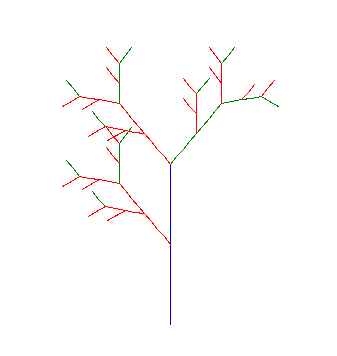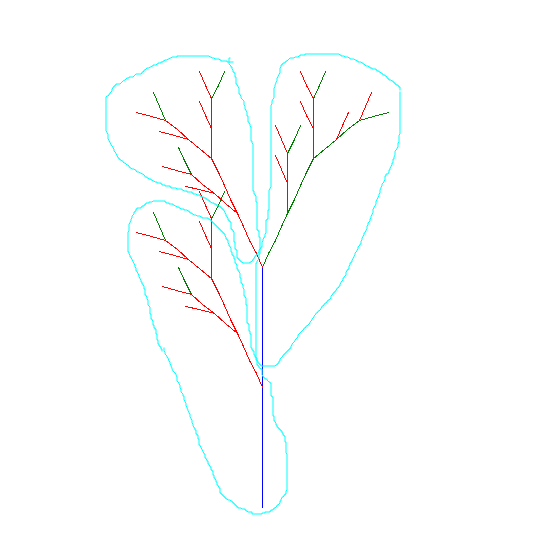Among the most conspicuous properties of a plant shape are symmetry and self-similarity.
In a nutshell, L-systems are based on three foundational ideas. The first idea is to represent plant structure with a string of characters. For example, suppose that a certain type of a plant is made of three kinds of elements: a trunk element I, a left leaf L, and a right leaf R. A little specimen of this plant, consisting of a single trunk element and two leaves, can be described with a string LRI (see Figure 5.5).

Note that any particular image is just an illustration of one of many possible looks of the LRI plant. The textual description does not really dictate any particular appearance, it is only responsible for the internal structure of the entity we describe.
Having enough patience, one can create fairly complicated plants using this approach, but in practice the description strings quickly become long and difficult to work with. Thus, the second foundational idea is to specify the developmental rules of the plant in the form predecessor → successor
We can make our LRI plant growable by introducing a new element A (“root”) and specifying its developmental rule:
A → ALRI
Now let’s “seed” the initial plant, consisting only of the root element A. After three applications of the developmental rule, we will obtain a “triple-LRI” plant (see Figure 5.6):
A → ALRI → ALRILRI → ALRILRILRI

Summing up, an L-system is a description of a plant structure, consisting of an initial string (called an axiom) and a set of production rules that determine how individual symbols “grow” into strings. On each “growth step” all the symbols of the current string are substituted according to the rules. It is also presumed that no rules are in conflict, so if we have a rule A → B, there should be no alternative rule A → C.
As a more complex example, consider the evolution of the axiom g according to the production rule g → g[+g][-g]:
step 0: g
step 1: g[+g][-g]
step 2: g[+g][-g][+g[+g][-g]][-g[+g][-g]]
This way, every occurrence of g in the current string becomes g[+g][-g] at the next step. This process can go on forever, but in practice it is usually interesting to watch the evolution of a certain axiom over the predefined number of generations or simply visualize the final result.
The third and the final foundational idea of L-systems is to treat the textual description of a plant structure as a script, executable by a certain visualization module.
While there is no single “right” approach to interpret plant description strings, a commonly suggested way to get started is to treat individual characters as turtle commands.

import turtle from dataclasses import dataclass WIDTH = 1200 HEIGHT = 800 PEDESTRAL = 100 # a simple plant with a bud AXIOM = "A" RULES = {"A": "g[+A][-A]"} ANGLE = 20 DISTANCE = 25 STEPS = 6 # the LRI plant with a bud # AXIOM = "A" # RULES = {"A": "AILR", "I": "g", "L": "[+g]", "R": "[-g]"} # ANGLE = 30 # DISTANCE = 20 # STEPS = 4 # another example plant # AXIOM = "X" # "g" # RULES = {"X": "g[+X]g[-X]+X", "g": "gg"} # ANGLE = 40 # DISTANCE = 10 # STEPS = 4 # AXIOM = "X" # RULES = {"X": "g-[[X]+X]+g[+gX]-X", "g": "gg"} # ANGLE = 22.5 # DISTANCE = 10 # STEPS = 4 # AXIOM = "X" # RULES = {"X": "g[+X]g[-X]+X", "g": "gg"} # ANGLE = 25 # DISTANCE = 15 # STEPS = 4 # AXIOM = "g" # RULES = {"g": "gg-[-g+g+g]+[+g-g-g]"} # ANGLE = 22.5 # DISTANCE = 6 # STEPS = 4 # AXIOM = "X" # RULES = {"X": "g[+X][-X]gX", "g": "gg"} # ANGLE = 25.7 # DISTANCE = 3 # STEPS = 7 # AXIOM = "f" # RULES = {"f": "f+g", "g": "f-g"} # ANGLE = 90 # DISTANCE = 10 # STEPS = 7 # AXIOM = "g-g-g-g" # RULES = {"g": "g-g+g+gg-g-g+g"} # DISTANCE = 4 # ANGLE = 90 # STEPS = 3 # AXIOM = "g" # RULES = {"g": "g[+g][-g]"} # ANGLE = 20 # DISTANCE = 25 # STEPS = 6 def setup_screen(title): turtle.setup(WIDTH, HEIGHT) # turtle.tracer(0, 0) turtle.title(title) @dataclass class LSystem: script: str @classmethod def create(cls): r = cls(AXIOM) for i in range(STEPS): r.transform() return r def transform(self): self.script = "".join([self.apply_rule(c) for c in self.script]) def apply_rule(self, c): return c if c not in RULES else RULES[c] def draw(self, drawer): while self.script: c = self.script[0] self.script = self.script[1:] if c.islower(): drawer.forward(DISTANCE) turtle.update() elif c == "+": drawer.color("red") drawer.left(ANGLE) elif c == "-": drawer.color("green") drawer.right(ANGLE) elif c == "[": self.draw(drawer.clone()) elif c == "]": return setup_screen("L-systems") drawer = turtle.Turtle() # place at the bottom, point upward drawer.color("blue") drawer.hideturtle() drawer.penup() drawer.goto(0, -HEIGHT / 2 + PEDESTRAL) drawer.left(90) drawer.pendown() LSystem.create().draw(drawer) turtle.done()

# the LRI plant with a bud AXIOM = "A" RULES = {"A": "AILR", "I": "g", "L": "[+g]", "R": "[-g]"} ANGLE = 30 DISTANCE = 20 STEPS = 4

# another example plant AXIOM = "X" # "g" RULES = {"X": "g[+X]g[-X]+X", "g": "gg"} ANGLE = 40 DISTANCE = 10 STEPS = 4

AXIOM = "X" RULES = {"X": "g-[[X]+X]+g[+gX]-X", "g": "gg"} ANGLE = 22.5 DISTANCE = 10 STEPS = 4

AXIOM = "X" RULES = {"X": "g[+X]g[-X]+X", "g": "gg"} ANGLE = 25 DISTANCE = 15 STEPS = 4

Step 1: g[+X]g[-X]+X Step 2: gg[+g[+X]g[-X]+X]gg[-g[+X]g[-X]+X]+g[+X]g[-X]+X Step 3: gggg[+gg[+g[+X]g[-X]+X]gg[-g[+X]g[-X]+X]+g[+X]g[-X]+X]gggg[-gg[+g[+X]g[-X]+X]gg[-g[+X]g[-X]+X]+g[+X]g[-X]+X]+gg[+g[+X]g[-X]+X]gg[-g[+X]g[-X]+X]+g[+X]g[-X]+X Step 4: gggggggg[+gggg[+gg[+g[+X]g[-X]+X]gg[-g[+X]g[-X]+X]+g[+X]g[-X]+X]gggg[-gg[+g[+X]g[-X]+X]gg[-g[+X]g[-X]+X]+g[+X]g[-X]+X]+gg[+g[+X]g[-X]+X]gg[-g[+X]g[-X]+X]+g[+X]g[-X]+X]gggggggg[-gggg[+gg[+g[+X]g[-X]+X]gg[-g[+X]g[-X]+X]+g[+X]g[-X]+X]gggg[-gg[+g[+X]g[-X]+X]gg[-g[+X]g[-X]+X]+g[+X]g[-X]+X]+gg[+g[+X]g[-X]+X]gg[-g[+X]g[-X]+X]+g[+X]g[-X]+X]+gggg[+gg[+g[+X]g[-X]+X]gg[-g[+X]g[-X]+X]+g[+X]g[-X]+X]gggg[-gg[+g[+X]g[-X]+X]gg[-g[+X]g[-X]+X]+g[+X]g[-X]+X]+gg[+g[+X]g[-X]+X]gg[-g[+X]g[-X]+X]+g[+X]g[-X]+X
AXIOM = "g" RULES = {"g": "gg-[-g+g+g]+[+g-g-g]"} ANGLE = 22.5 DISTANCE = 6 STEPS = 4

AXIOM = "X" RULES = {"X": "g[+X][-X]gX", "g": "gg"} ANGLE = 25.7 DISTANCE = 3 STEPS = 7

AXIOM = "f" RULES = {"f": "f+g", "g": "f-g"} ANGLE = 90 DISTANCE = 10 STEPS = 7

AXIOM = "g-g-g-g" RULES = {"g": "g-g+g+gg-g-g+g"} DISTANCE = 4 ANGLE = 90 STEPS = 3

AXIOM = "g" RULES = {"g": "g[+g][-g]"} ANGLE = 20 DISTANCE = 25 STEPS = 6






【推荐】国内首个AI IDE,深度理解中文开发场景,立即下载体验Trae
【推荐】编程新体验,更懂你的AI,立即体验豆包MarsCode编程助手
【推荐】抖音旗下AI助手豆包,你的智能百科全书,全免费不限次数
【推荐】轻量又高性能的 SSH 工具 IShell:AI 加持,快人一步
· 震惊!C++程序真的从main开始吗?99%的程序员都答错了
· 【硬核科普】Trae如何「偷看」你的代码?零基础破解AI编程运行原理
· 单元测试从入门到精通
· 上周热点回顾(3.3-3.9)
· winform 绘制太阳,地球,月球 运作规律